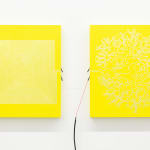Joyce Hinterding
Further images
Analogue Synthesis, for me, begins with oscillation and feedback, a phenomenon that not only appears in electronics and sound, but also in cellular structures, plants, and the everyday world, from the positive feedback characterised by amplification to the negative feedback required for maintaining equilibrium or homeostasis. In the world of electronics, these dynamic and energetic processes are described using signs and symbols to form circuits.
LC Lichen Oscillator (cadmium Yellow) utilises the conductivity of gold and silver to translate the dynamic states required by a circuit, such as induction (L) and capacitance (C ) to produce a speculative piece of electronics that is energised by the surrounding electromagnetic activity. The components follow basic principles but are based on aesthetic observations and translations of Lichen photographed in the Blue Mountains.
LC Lichen Oscillator (cadmium Yellow) is a pairing of an active antenna that scavenges electromagnetic energy and a capacitor based on a fractal algorithm by Stanislav Ulam that stores this energy like a battery. Together, this pairing forms one of the most enigmatic yet fundamental mechanisms in electronics: the tuned or resonant circuit. Commonly called the Tank circuit or the LC circuit, this circuit has only two components an Inductor (a coil or a loop of conductive material) and a capacitor (a short-term battery). Once this circuit is energised, it begins to oscillate. Although graphically large, the components are electrically small and are energised by very modest local electromagnetic fields; as a result, the work oscillates in the inaudible MHZ range.
The scavenging ability of the work can be heard in the headphones.














